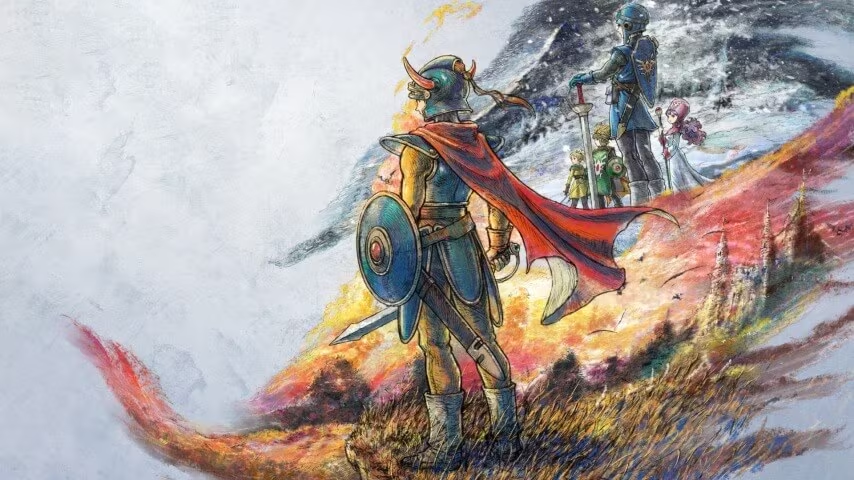The Primal Distillation of a Genre
For millions of players across the globe, the experience of Dragon Quest can be distilled into a single, foundational moment: the first encounter with a Slime. This simple, teardrop-shaped blue creature, designed by the legendary Akira Toriyama, is the ultimate symbol of the franchise. When playing the recently released Dragon Quest I & II HD-2D remakes, that encounter remains the immediate, primal touchstone, instantly connecting modern players to the series’ 1986 origins.
Yet, this immediate hit of nostalgia raises a profound question: Can a faithful remake of a foundational text achieve the same cultural resonance in the highly saturated gaming landscape of 2025 that the original did when it essentially invented the Japanese Role-Playing Game (JRPG) genre nearly four decades ago? The remakes, while visually stunning and meticulously crafted, are engaged in a delicate balancing act—preserving history while searching for contemporary relevance.
The HD-2D Philosophy: Preserving History with Modern Fidelity
The choice of the HD-2D graphical style—pioneered by Square Enix titles like Octopath Traveler and Live A Live—is central to this quest for relevance. This aesthetic is not merely a graphical upgrade; it is a philosophical statement. It combines the nostalgic charm of 16-bit pixel art with modern 3D environments, lighting, and particle effects. This approach ensures that the visual identity of the original games remains intact, but is presented with a depth and clarity that appeals to contemporary expectations.

For veterans, the HD-2D style offers a high-fidelity memory of the past. For newcomers, it provides a visually unique entry point that stands apart from the hyper-realistic graphics dominating the market. This deliberate design choice acknowledges that the original games, particularly the first Dragon Quest, were technologically constrained by the Famicom hardware. The remake allows players to experience the spirit of the original vision without the limitations of the 8-bit era.
The Original Revolution: Defining the JRPG
To understand the challenge facing the remakes, one must recall the revolutionary impact of the original Dragon Quest (released as Dragon Warrior in North America). Launched in Japan in 1986, it was the first console RPG to achieve widespread mainstream success. It established the core conventions that would define the genre for decades:
- Turn-Based Combat: Simple, menu-driven encounters.
- Progression Loop: Defeating monsters, earning experience, leveling up, and acquiring better equipment.
- Fantasy Narrative: A lone hero (the descendant of Erdrick) tasked with saving the kingdom from a great evil (the Dragonlord).
- Overworld Exploration: Navigating a large map between towns and dungeons.
In the late 1980s, Dragon Quest was a cultural phenomenon in Japan, leading to massive lines outside stores and even prompting the government to request that future releases be moved to weekends to prevent truancy. It was an event that fundamentally changed the perception of what a console game could be, paving the way for rivals like Final Fantasy.

Modernizing the Classic Formula: Quality-of-Life vs. Integrity
The simplicity and deliberate pacing that made the original Dragon Quest revolutionary in 1986 are often perceived as tedious or slow in 2025. Modern JRPGs prioritize efficiency, minimizing the ‘grind’ and maximizing narrative velocity. Consequently, the HD-2D remakes must incorporate significant quality-of-life (QoL) updates to remain palatable to a modern audience.
These necessary changes fundamentally alter the experience. The original game’s punishing difficulty and slow pace—which required players to spend hours grinding for gold and experience—were integral to its sense of scale and accomplishment. Every step felt earned, and every victory felt monumental. The remakes, by necessity, streamline these elements:
- Faster Movement and Combat: Reducing the time spent traversing the map and waiting for combat animations.
- Streamlined Inventory: Modernized menus and item management.
- Improved Experience Gain: Adjusting the economy and leveling curve to reduce mandatory grinding.
While these QoL improvements make the game more accessible, they run the risk of diminishing the very elements that made the original so impactful. The sense of isolation and the sheer effort required to defeat the Dragonlord are lessened when the journey is made significantly easier. The challenge for the developers is determining where to draw the line between preservation and modernization.
The Quest for Cultural Resonance in 2025
The cultural landscape of gaming is vastly different today. Dragon Quest is no longer the sole pioneer; it is one of thousands of high-quality JRPGs released annually. The remakes are not competing against a nascent market, but against massive, globally recognized franchises that have evolved the genre in countless directions.
In this context, the Dragon Quest I & II HD-2D remakes cannot hope to replicate the sheer cultural weight of the 1986 original. Their goal shifts from being a revolutionary product to being a definitive historical document—a highly polished, accessible version of a foundational text.
“The remakes serve as a reminder of the genre’s humble, yet brilliant, beginnings. They are designed less to redefine gaming in 2025 and more to ensure that the origin story of the JRPG remains playable and appreciated by new generations.”
By focusing on the HD-2D aesthetic and implementing smart QoL updates, Square Enix is attempting to carve out a niche where nostalgia meets accessibility. They are selling the purity of the original design, emphasizing the genius of Yuji Horii’s simple, elegant mechanics and Toriyama’s iconic character designs.

Key Takeaways: The Remake’s Success
The Dragon Quest HD-2D remakes ultimately succeed not by trying to replicate the original’s cultural impact, but by perfecting its presentation and accessibility. They offer a masterclass in how to modernize a classic without sacrificing its soul.
- Visual Fidelity: The HD-2D style successfully updates the 8-bit graphics, making the games visually appealing to modern audiences while retaining the classic aesthetic.
- Accessibility: Necessary quality-of-life improvements streamline the experience, reducing the tedious grind often associated with early JRPGs.
- Historical Value: The remakes function as vital historical artifacts, ensuring that the foundational mechanics of the JRPG genre remain easily playable.
- Core Identity Preserved: Despite modernization, the essential charm, narrative simplicity, and iconic art style remain the core appeal.
Conclusion: A Definitive History
The Dragon Quest I & II HD-2D remakes are not a quest for renewed revolution; they are a quest for definitive preservation. They acknowledge that the role of a classic has changed. In 1986, Dragon Quest was the future; in 2025, it is history. The remakes ensure that this history is presented in the best possible light, allowing players to experience the foundational brilliance of the JRPG genre without the friction of outdated mechanics. They may not generate the same cultural fervor as their predecessors, but they secure the legacy of Erdrick’s descendants for decades to come.
Originally published: November 24, 2025
Editorial note: Our team reviewed and enhanced this coverage with AI-assisted tools and human editing to add helpful context while preserving verified facts and quotations from the original source.
We encourage you to consult the publisher above for the complete report and to reach out if you spot inaccuracies or compliance concerns.

